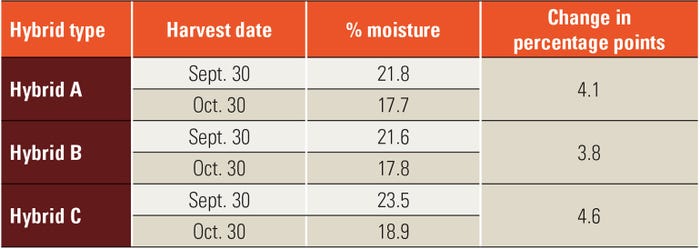
Should you harvest corn when you’re ready and ground conditions are good, even if moisture content is 20% to 25%, or should you wait and let it dry in the field? It’s a question as old as the practice of shelling corn itself. And it was asked often in 2020, as good weather made corn harvest possible by Oct. 1 or earlier in some locations. Yet in some cases, moisture content was still at 20% or higher.
You won’t get the definitive answer here. But you will get one more quality observation of how three hybrids left for an additional 30 days, from Sept. 30 to Oct. 30, dried in the field.
The two harvest dates are part of an exclusive experiment set up by Indiana Prairie Farmer in cooperation with the Purdue University Throckmorton Agricultural Center. Bob Nielsen, Purdue Extension corn specialist, is the agronomist responsible for the project. Pete Illingworth, on the Throckmorton staff, helps supervise harvest and determines moisture readings, using the moisture tester at the ag center. The entire trial consists of harvesting three different hybrids at three different times: late September, late October and, ideally, late November. Beck’s supplied the three hybrids for the trial, replicated four times, plus a hybrid for buffer strips included within the trial.
It’s similar to a trial conducted in 2019 with two hybrids. Because maturity was so late in 2019, the first harvest date wasn’t until the week of Oct. 20, and harvest ended in December. There was no hidden yield loss, meaning no invisible loss due to unknown factors, in 2019. Because there is typically little good drying weather from late October on, harvest moistures tend to decline only modestly, and 2019 was no exception.
2020 examples
Data from Iowa State University says corn typically dries down by 0.25% to 0.5% moisture points per day during October. Nielsen has noted in previous articles that rate of drydown in the field depends on many factors, including weather and hybrid differences. Generally, the warmer it is with less humidity, the better the drying.
Here is actual data on the three hybrids in the 2020 trial harvested at the Throckmorton Ag Center near Romney, Ind.

If you use 0.25 to 0.5 per day as a guideline, moisture loss of 7.5 to 15 points would be possible in a month. However, not every day is a drying day. Plus, once hybrids reach 20% or below, drying tends to slow, Nielsen says.
The average daily gain based on averaging these three hybrids together was just under 0.15 point per day.
The first half of October tended to be dry and warmer than normal at the site, Illingworth notes. However, the back half of the month featured several cloudy, rainy days, with over 2 inches of total rainfall.
About the Author(s)
You May Also Like




